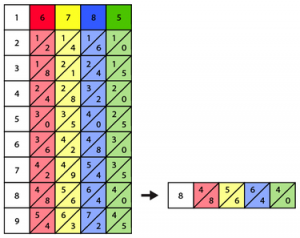In 1617, mathematician John Napier produced his bones, or rods, as a means of accurate multiplication and division. These were improvements on earlier work by by Matrakci Nasuh and Fibonacci. It was a huge step forward in accuracy and speed of computation for mathematicians and all scientists. It allowed a simple, visual way to add numbers with single digit multiplication removed to prevent errors.

In the example below, to multiply 8 times 6785, you simply line up four bones on the board and read across at the 8. The product 54,280 is the result of adding the numbers (8+5 and 6+6 both carry).

William Oughtred is credited for producing the first slide rule in 1622, as well as coining sine and cosine and “x” for multiplication. The slide rule did not allow for as many digits of precision as Napier’s bones, but certainly increased the speed of mathematical calculation. One can compute two 2-digit numbers faster with a slide rule than with a calculator.
Visit the Virtual Slide Rule for a testable example of how the slide rule works. First, slide the centre bar to until the 1 on the B scale is under the 2 on the A scale. Now look to the right at the 3 on the B scale, which is now under the 6 on the A scale. 2×3=6. Look also at the K scale which is used for cubing numbers. 2 on the B scale is under the 8, so 2^3=8. The numbers between the integers can be used as decimals or smaller numbers (e.g. 1.5 in place of 15). You only need to keep track of the powers of 10.
Later, in 1891, French railway engineer Henri Genaille improved upon Napier’s work with the
Genaille–Lucas rulers. The rulers removed the additions necessary in Napier’s bones, increasing speed and accuracy. The pointing lines on Genaille’s rulers removed the need for addition, greatly reducing errors in multiplying large numbers.
In the image below, multiplying 3 by 52,749 (158,247) requires only noting the digits from right to left. Start with the 7 (3×9), then move left where the lines point.

The images are taken from wikipedia. The virtual slide rule is from Antiquark.
